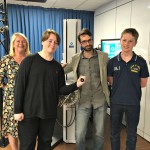A team of academics from the BU’s Design and Engineering Department in collaboration with Royal Bournemouth Hospital and Zimmer Biomet, an international medical device company, have just started a new research project. The aim is to investigate the difference between various joint fore sensor developed by different manufacturers. It is speculated that the knowledge of exact initial load intensity in joint during surgery and tracking its position is important and has a direct impact on the outcome of orthopaedic surgeries.
The aim is to use available knee joint force and tracking transducers to evaluate their performance when measuring both structural and dynamics integrity of knee joint during and after TKRA. Ideal load balance in the knee increases the life of the knee, reduces pain and discomfort, improved gait symmetry, improve range of motion hence promoting close to normal activities such as running or jugging. Our team is led by Prof A. Harvey, a consultant knee specialist at RBCH supported by Professor Siamak Noroozi. Other members of the team are Dr. Roya Haratian, Ms Samira Al-Nasser plus external supervisors/advisors.
This project’s aim is to investigate the effectiveness of the use of the new generation of smart joint transducers within the clinical setting, using Cadaver. The objective of this investigation is to inform orthopaedic operations/surgery in real time needed to achieve optimum load and load balance.
Accurate measurement, tracking and balancing of the joint contact force is directly linked to the in-service performance of the joint and its durability. Current practices in setting the ideal joint tension or assessing optimum joint kinematics during joint operation, are subjective and artisan at best. The aim of this investigation is to evaluate if exact and repeatable joint forces that can be measured or set during operation. The new generation of smart sensors can track and measure the contact forces and contact location and kinematic performance of the joint in real time.
Optimum kinematics and optimum load balancing can potentially extend the life of the implant, minimising the risk of premature joint failure that requires expensive revision surgery. The transducer validation procedure will include assessments of reliability, ease of application, relative accuracy against benchmarks, if available, as well as and structural and dynamics integrity of the joint, to show their effectiveness as compared to an overall load measurement using hand or Robotics manipulators. Other issues such as compliance with relevant BSI (British Standard Institution) and MHRA (Medicine and Health Regulatory Agency) will also be investigated.
It is speculated that joint force tracking and balancing artefacts/transducer technologies can improve the outcomes of all orthopaedic surgeries. This is done by improving the accuracy and repeatability of the joint replacement surgery. A useful transducer should be able to accurately measure the joint contact forces and track its location over the surface of the insert in real time. This, in time, can lead to identifying the ideal joint load intensity and its relationship to age, gender, size etc..
The NJS (National Joint Registry) reports that on average every year 11% of hip, 6% of knee, 1% of ankle, 11% of shoulder, and 33% of elbow joints require surgical revision. This costs the NHS (National Health Services) around £2,000,000,000 every year. Our technology will reduce the subjectivity of primary joint replacement surgery, minimise risks, and improve outcomes. In turn this will reduce the need for revision joint replacement surgery and result in a much more cost-effective service.
Number of joint surgeries and the need for revision in 2016 [NJS Report 2016]An ideal system should use a combination AI (Artificial Intelligence) as well as , IMU (Inertial Measurement Unit), Image processing, and in-depth knowledge of Mechanical and Electrical/Electronics engineering, GUI (Graphical User Interface designs), Signal Processing, Material science and control strategies.
Through a a number of cadaveric studies, the project will evaluate the validate the and effectivness of such transducer’s operation. We will also increase our understanding of the need for optimum joint tension intra-operatively, so that we can use the transducer safely and effectively during knee joint replacement surgery.
This outcome of this research will help to improve our understanding of the forces involved and the outcome of all joint replacement surgeries. Such tools help surgeons to make real time fine adjustments during the procedure to ensure optimal component implantation. This innovative approach will allow accurate and instantaneous intraoperative assessment of joint contact forces and tracking its location. We also anticipate that these studies will further our understanding of the optimal load intensity in joints and the surrounding tissues. During the operation, the smart/intelligent transducer element of the system will enable surgeons to accurately track and measure the joint contact forces and location and the resulting muscle tensions at various positions and orientations.
This project will bring together some large institutions such as the NHS, Zimmer Biomet –UK and several very skilled surgeons, and engineers, allowing implementation of these medical devices. This is in keeping with the industrial strategy document relating to early diagnosis and precision medicine, healthy ageing, cutting-edge healthcare which the government identifies as a strategic area of investment.
These new technologies also support the need for the development of new mechatronics degree or specialist unit for those studying medical, biomedical, and biomechanical related degrees. This research can also be attractive as short courses to train/up-skill experienced doctors and orthopaedic surgeons. This will enable Bournemouth University to become a centre of excellence for all UK joint force measurement and kinematic assessment research.
The social impact of this project would be in terms of improving living standards and economic growth by increasing productivity and driving growth across the whole country (Department for Business, Energy & Industrial Strategy, 2017). The NJR (National Joint Registry) data as evidenced in Figure 1 also shows the need for the growth in industries that inform joint surgeries. This is due to the cost of unscheduled revision surgeries due to mechanical failure of the joint from excess loading or poor alignment etc. This indirect cost saving comes from reduction of revision surgeries as the result of using our technologies. Hence reducing cost while improving quality of care using advanced technologies. The report also highlights, it is essential that all options that could improve the nation’s health related businesses for the long term are explored for possible investment. This will provides a long-term solutions that both directly and indirectly improve the quality of life of those who need or depend of surgical intervention or need assistive technologies, or GPs who need to monitor performance without the need for referring to large specialist centres, or consultants who wish to predict plan their surgeries in advance and need to determine the required mechanical advantages of their interventions.
Such tools will reduce the pressure on GPs & orthopaedic surgeons. It also over time creates the database of good practices towards the gold standard of “Getting it right first time”, which reduces NHS cost and the pressure they work under. For patients, it means improved quality of life by minimising the needs for future revision surgeries and faster recovery to more normal or symmetric gait hence reducing pain and/or fatigue etc.
 Bournemouth University Researchers Win ‘Innovation Oscar’ for Third Year in a Row
Bournemouth University Researchers Win ‘Innovation Oscar’ for Third Year in a Row A great opportunity from the collaboration of Bournemouth University and Nuffield Foundation
A great opportunity from the collaboration of Bournemouth University and Nuffield Foundation New Research Collaboration between Bournemouth University and La Trobe University, Melbourne, Australia
New Research Collaboration between Bournemouth University and La Trobe University, Melbourne, Australia










 Fourth INRC Symposium: From Clinical Applications to Neuro-Inspired Computation
Fourth INRC Symposium: From Clinical Applications to Neuro-Inspired Computation Writing policy briefs
Writing policy briefs Upholding Excellence: The Concordat to Support Research Integrity
Upholding Excellence: The Concordat to Support Research Integrity Today’s Documentation Will Serve Tomorrow’s Justice
Today’s Documentation Will Serve Tomorrow’s Justice ECR Funding Open Call: Research Culture & Community Grant – Application Deadline Friday 12 December
ECR Funding Open Call: Research Culture & Community Grant – Application Deadline Friday 12 December MSCA Postdoctoral Fellowships 2025 Call
MSCA Postdoctoral Fellowships 2025 Call ERC Advanced Grant 2025 Webinar
ERC Advanced Grant 2025 Webinar Horizon Europe Work Programme 2025 Published
Horizon Europe Work Programme 2025 Published Horizon Europe 2025 Work Programme pre-Published
Horizon Europe 2025 Work Programme pre-Published Update on UKRO services
Update on UKRO services European research project exploring use of ‘virtual twins’ to better manage metabolic associated fatty liver disease
European research project exploring use of ‘virtual twins’ to better manage metabolic associated fatty liver disease